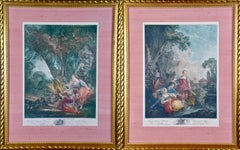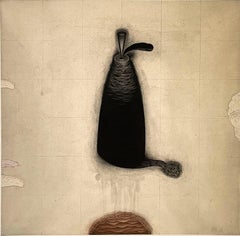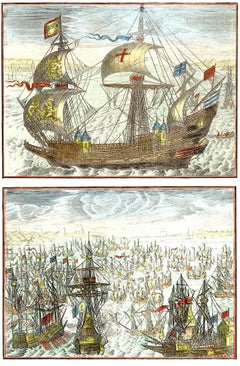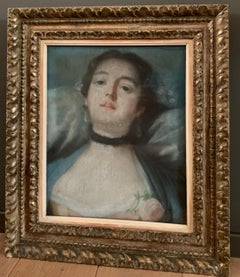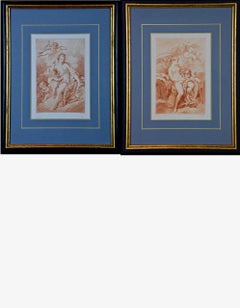(After) Francois Boucher Art
to
1
Overall Width
to
Overall Height
to
1
1
1
1
1
1
1
1
1
9,439
2,689
1,374
1,362
1
1
Artist: (After) Francois Boucher
Pair of Hand-colored Romantic French Engravings after Francois Boucher
By (After) Francois Boucher
Located in Alamo, CA
A pair of French classical romantic prints original created in the 18th century by Jacques-Firmin Beauvarlet (1731-1797) after paintings by Francois Boucher (1703-1770), utilizing ...
Category
18th Century Romantic (After) Francois Boucher Art
Materials
Engraving, Etching
Related Items
The Mountain
Located in Palm Springs, CA
Mezzotint print. Edition of 18, signed, titled and numbered by the artist.
Caulfield has exhibited his prints, drawings, installations and artist’s books extensively throughout Cana...
Category
Early 2000s Surrealist (After) Francois Boucher Art
Materials
Mezzotint
Two naval images depicting 17th century warships
Located in Middletown, NY
French School 20th century
Two naval images depicting 17th century warships flying various flags, including the Plantagenet Lions and St. George's Cross. (2)
c1950. Two engravings w...
Category
20th Century French School (After) Francois Boucher Art
Materials
Watercolor, Engraving
Magnolia 10 - Contemporary Figurative Drypoint Etching Print, Flower, Floral
By Marta Wakula-Mac
Located in Warsaw, PL
MARTA WAKUŁA-MAC: Master of Arts in Fine Art Education- Diploma in Fine Art Printmaking at the Institute of Art, Pedagogical University, Krakow, 2003. Member of Graphic Studio Dubl...
Category
2010s Contemporary (After) Francois Boucher Art
Materials
Paper, Drypoint, Etching
Heinrich Ulrich after Paul Mair, Guard of Emperor Rudolph, Soldier, Landsknecht
Located in Greven, DE
Heinrich Ulrich (aka Heinrich Ullrich) (fl.1567–1621)
“Soldier with Hellebarde”, 1598, out of the series, “The Guard of Emperor Rudolph” (aka “Old German Soldiers...
Category
16th Century Renaissance (After) Francois Boucher Art
Materials
Engraving
Presse Ludovico Mirri Mercante d’Quadri incentro al Palazzo Bernini a Roma No.42
By Marco Carloni
Located in Paonia, CO
Presse Ludovico Mirri Mercante d’Quadri incontro al Palazzo Bernini a Roma No.42 is from a series of original engravings published by Lodovico Mirri in the late 18th century and engr...
Category
Late 18th Century (After) Francois Boucher Art
Materials
Engraving
Tool Drypoint: Paintbrush by Jim Dine, black and white tool still life sketch
By Jim Dine
Located in New York, NY
Jim Dine drew the plate for this image in the same period as his “Thirty Bones of My Body” 1972 portfolio of drypoint tool images. Crisbrook paper (30 x 22 in. / 76.2 x 56 cm.) and p...
Category
1970s Modern (After) Francois Boucher Art
Materials
Drypoint
Hole Punch (Jim Dine 30 Bones of My Body portfolio) tool dry point
By Jim Dine
Located in New York, NY
The hand tool is undoubtedly Jim Dine’s most iconic motif. Meticulously catalogued in rows like scientific specimens or sketched individually, hammers, awls, brushes, saws and screwd...
Category
1970s Pop Art (After) Francois Boucher Art
Materials
Drypoint
$3,000
H 30 in W 22 in
Les Caprices Pinces Princiers (Frank Hunter Authenticated)
By Salvador Dalí
Located in Aventura, FL
From Les Diners De Gala. Photo lithograph with a separate original engraving titled Spoon on Crutches. Hand signed by Salvador Dali. Hand numbered 170/395.
Frame size approx 29 x ...
Category
1970s Surrealist (After) Francois Boucher Art
Materials
Paper, Engraving, Lithograph
$1,837 Sale Price
25% Off
H 29 in W 34 in D 1 in
Two botanical prints after Cornelisi Bloemaert & Vincenzo Leonardi
Located in Middletown, NY
Two botanical prints after Cornelis Bloemaert & Vincenzo Leonardi
"Lemon", from Hesperides. Reproductive print on thick C.M. Fabriano cotton wove paper; and Pierre Joseph Buchot (17...
Category
Late 17th Century French School (After) Francois Boucher Art
Materials
Watercolor, Engraving
$200
H 22.05 in W 14.77 in
Tool Drypoint: Bottle opener by Jim Dine, black and white tool still life sketch
By Jim Dine
Located in New York, NY
Jim Dine drew the plate for this image in the same period as his “Thirty Bones of My Body” 1972 portfolio of drypoint tool images. Crisbrook paper (30 x 22 in. / 76.2 x 56 cm.) and p...
Category
1970s Modern (After) Francois Boucher Art
Materials
Drypoint
Pablo Picasso (after) Helene Chez Archimede - Wood Engraving
By (after) Pablo Picasso
Located in Collonge Bellerive, Geneve, CH
Pablo Picasso (after)
Helene Chez Archimede
Medium: engraved on wood by Georges Aubert
Dimensions: 44 x 33 cm
Portfolio: Helen Chez Archimede
Year: 1955
Edition: 240 (Here it is on...
Category
1950s Cubist (After) Francois Boucher Art
Materials
Engraving
$1,289
H 17.33 in W 13 in D 0.04 in
Trivium MMV
By Francisco Souto
Located in New Orleans, LA
In medieval universities, the trivium comprised the three subjects that were taught first: grammar, logic, and rhetoric. The word is a Latin term meaning "the three ways" or "the thr...
Category
Early 2000s American Modern (After) Francois Boucher Art
Materials
Mezzotint, Lithograph, Screen
Previously Available Items
French 18th century rococo pastel portrait "La voluptueuse "
By (After) Francois Boucher
Located in Aartselaar, BE
French 18th (or early 19th) century rococo pastel portrait painting of a teasing lady, based on the famous work by François Boucher.
While this present ...
Category
19th Century Rococo (After) Francois Boucher Art
Materials
Paper, Oil
H 19.69 in W 15.75 in D 1.19 in
A Pair of Romantic Etchings of Women with Cherubs by Pequegnot after Boucher
By (After) Francois Boucher
Located in Alamo, CA
Each of these tinted etchings depicts a young woman with cherubs (putti), one of which holds an arrow, possibly representing Cupid. These etchings we...
Category
Mid-19th Century Rococo (After) Francois Boucher Art
Materials
Etching
H 18.88 in W 13.82 in D 0.75 in
"The Toilette of Venus"
By (After) Francois Boucher
Located in Houston, TX
Etching done after Francois Boucher's "The Toilette of Venus." He is a 18th century artist who worked with a lot of naturalistic mythology themes. The...
Category
19th Century Academic (After) Francois Boucher Art
Materials
Etching
(after) Francois Boucher art for sale on 1stDibs.
Find a wide variety of authentic (After) Francois Boucher art available for sale on 1stDibs. You can also browse by medium to find art by (After) Francois Boucher in etching, engraving and more. Not every interior allows for large (After) Francois Boucher art, so small editions measuring 18 inches across are available. (After) Francois Boucher art prices can differ depending upon medium, time period and other attributes. On 1stDibs, the price for these items starts at $200 and tops out at $2,375, while the average work can sell for $1,288.
Questions About (After) Francois Boucher Art
- What is Boucher jewelry?1 Answer1stDibs ExpertMay 14, 2024Boucher jewelry is jewelry created by the firm founded by French designer Marcel Boucher. In the the 1920s, Boucher moved to New York City from his native country. In 1937, he founded his own jewelry house after having apprenticed with Cartier and worked as a designer for Mazer Bros. The brand quickly became known for its enameled costume jewelry. By the end of the 1940s, Boucher hired (and later married) another designer named Sandra Semensohn. On 1stDibs, shop a collection of vintage Boucher jewelry.
- 1stDibs ExpertSeptember 23, 2024To identify Boucher jewelry, look for the maker's markings. Nearly all pieces feature a maker's mark. Depending on the age of your piece, the markings may be the word “Marboux” on early pieces, the initials "MB" in a cartouche or the names “Marcel Boucher” or “Boucher” on their own. After 1945, Marcel Boucher began adding an inventory number to his pieces, and Boucher continues this tradition today. You can look this inventory number up in trusted online resources to learn more about your jewelry. If you need any help with the identification process, consult a certified appraiser or knowledgeable dealer. Shop a diverse assortment of Boucher jewelry on 1stDibs.
